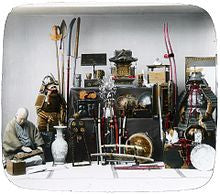Votre panier est vide


Also known as bushi and buke, samurai warriors have been instrumental in shaping Japan's culture and history. Members of the country's pre-modern military caste, they were an elite fighting force that used special weapons and tactics to overcome opposing forces.
Straight-Blade Swords
Japan's first samurai warriors wielded straight-blade swords, such as the chokutō, as their primary weapon. Historians believe the design for these straight-blade swords were derived from China, which had similar swords at the time.
Curved-Blade Swords
As Japan refined the art of swordmaking, it began producing curved-blade swords for samurai warriors. The two most popular curved-blade swords were the uchigatana, and later its successor, the katana.
Transitioning from a straight blade to a curved blade offered several key benefits to samurai warriors, one of which was improved slicing and slashing. When slashing, the curve pulls the blade through the samurai's opponent more fluidly and naturally. Curved-blade swords were also more effective to use while on horseback than their straight-blade counterpart.
Companion Blades
In addition to a full-sized sword, samurai warriors also carried a smaller companion blade. There was even a name used to describe the act of wielding a full-sized sword and a companion sword: daishō (translates to "big and small"). Common companion blades wielded by samurai warriors during feudal Japan include the wakizashi and tantō.
Similar to the way in which modern-day soldiers carry a rifle and sidearm, daishō offered greater versatility to samurai warriors on the battlefield. If their primary sword was lost or broken -- or if they found themselves in close-quarter combat -- they could switch to their companion blade.
The Yumi
Samurai warriors weren't limited to fighting with swords. Many samurai wielded a longbow known as the yumi. Emphasized in Japan's art of kyujutsu, the yumi allowed samurai warriors to engage enemies from a safe distance. Its usage began to decline, however, during the Sengoku period (1467 to 1603) when the matchlock was invented.
Pole Blades
Samurai warriors have also been known to wield pole blades. The yari is one such pole blade that saw extensive use during feudal Japan. Featuring a characteristic design that's similar to China's spears, the yari was a straight-headed, spear-like weapon with a length of 15 to 21 feet.
The naginata was a similar type of pole-bladed weapon used by samurai warriors. It consists of a wooden or metal pole with a curved blade on the end. Additionally, the naginata features a round handguard to protect the warrior's hands, much like the katana's tsuba.